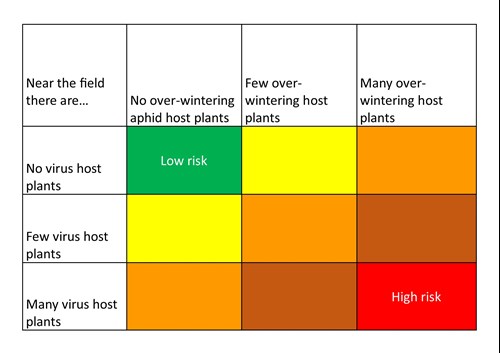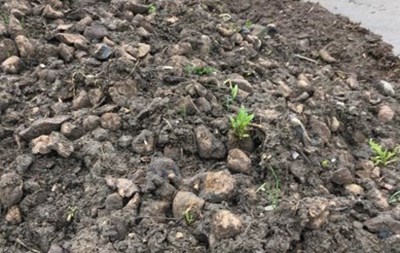Using good farm-hygiene to control the Green Bridge
Attention to detail is key to controlling the green bridge:
- Clear and destroy any remaining spoil heaps before the new crop emerges
- Remove all crop debris under cleaner loaders and around clamps
- Remove any groundkeepers from fields
- Keep crop volunteers and weed species under control with well-timed, comprehensive herbicide programmes
An example of the Green Bridge effect in action...
Several beet plants are left behind in the field after harvesting. One of these plants had become infected with BYV over the summer. This beet had been topped but survives through the mild winter and produces fresh leaves the following spring. These fresh, young leaves attract Myzus persicae aphids migrating from a nearby hedge, where they have been overwintering on weeds. The aphids feed on this plant before moving off into the neighbouring field of recently drilled beet – so introducing BYV into the new beet crop.
By maintaining good farm-hygiene and removing these groundkeepers the risk of virus entering the new beet crop is reduced.
Understanding your virus yellows risk…
The Virus Yellows Forecast (released annually in March) uses over winter temperatures to model the risk of virus yellows in each factory area for the coming season. This forecast will give an early warning of the anticipated risk to crops on a regional level.
The existing yellow water-pan network is used to monitor aphid migrations in real time, providing more localised information of aphid populations. The sugar beet aphids collected in these traps can then be tested for virus to ascertain the risk they pose to the crop.
…and at a field level
At a field level, virus yellows risk will be influenced by the frequency and proximity of aphid and virus host plants. The highest risk occurs when both over-wintering aphid hosts and virus sources are found close to the new beet crop.
Plant species to look out for
When determining the risk of virus yellows for a crop, the presence of both aphid host and virus host plants must be considered. In some cases the same species can be both an over-wintering aphid host and a virus host. These plants species pose the highest risk.
Aphid hosts
Myzus persicae has a large range of host plants including brassicas, potatoes, legumes, lettuce and sugar beet. However, brassica species appear to be their preferred over-winter host where they can survive as live adults and/or offspring. This puts beet crops neighbouring rape fields at particular risk of early infestation and potentially virus infection. Myzus persicae aphids can also overwinter as eggs on peach trees (hence the common name peach-potato aphid), although, in the UK, this is not a major source of aphids for the following spring crop.
Virus hosts
Infected sugar beet, either groundkeepers or leaf material on clamps, are one of the most important sources of virus. Some weed species can also be infected by beet viruses. Current known hosts of BYV and BMYV are listed below (BBRO testing is ongoing to update this list to include cover crop species and known insusceptible species):
BYV:
- Common chickweed (Stellaria media)
- Common orache (Atriplex patula)
- Common poppy (Papaver rhoeas)
- Common purslane (Portulaca oleracea)
- Corn spurry (Spergula arvensis)
- Garden orache (Atriplex hortensis)
- Red dead nettle (Laminum purpureum)
BMYV
- Scarlet pimpernel (Anagallis arvensis)
- Shepherd’s purse (Capsella bursa-pastoris)
- Corn marigold (Chrysanthemum segetum)
- Red dead nettle (Laminum purpureum)
- Common poppy (Papaver rhoeas)
- Groundsel (Senecio vulgaris)
- Corn spurry (Spergula arvensis)
- Common chickweed (Stellaria media)
- Field pansy (Viola arvensis)





